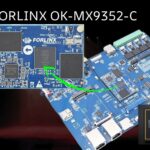MaxLinear, a leading technology innovator, has introduced the industry’s first single-chip Tri-band Wi-Fi 7 System-on-Chip (SoC) MxL31712, designed specifically for Wi-Fi 7 access points. This cutting-edge product is built on the upcoming IEEE 802.11be standard, also known as Extremely High Throughput (EHT), and boasts a peak throughput of 11.5 Gbps on the 6GHz (6E) spectrum – an impressive feat that doubles the speed of its predecessor, Wi-Fi 6.

The MxL31712 stands out with its exceptional features and specifications, making it a game-changer in the world of wireless connectivity
IEEE 802.11be Compliance: The MxL31712 adheres to the latest Wi-Fi standards, ensuring compatibility and optimal performance.
Wi-Fi Alliance™ Wi-Fi 7 Certifiable: This certification guarantees that the product meets industry standards, providing users with a reliable and high-performance wireless experience.
Impressive Throughput: With a bandwidth doubled to 320MHz and enhanced modulation at 4096 QAM, the MxL31712 achieves an outstanding peak throughput of 11.5Gbps on the 6GHz spectrum, surpassing the capabilities of Wi-Fi 6.
Spatial Streams: Supporting up to 12 spatial streams, the MxL31712 ensures efficient data transmission in various scenarios.
PHY Throughput: Boasting up to 18.6Gbps Physical Layer (PHY) throughput, this single-chip solution sets a new standard for wireless performance.
MaxLinear’s MxL31712 redefines the landscape of Wi-Fi access points with its innovative architecture, consolidating the Tri-band Access Point into a single Wi-Fi SoC. This not only reduces board complexity, lowers the Bill of Materials (BOM), and minimizes the form factor but also enhances overall performance and latency.
One of the standout features is the seamless coordinated view of data flows across multiple channels in dual- and tri-band configurations. This is particularly advantageous in congested environments like Multi Dwelling Units (MDUs), enabling faster recovery from retransmissions and ensuring a reliable and efficient network.
The “on-the-fly MAC” architecture is another highlight, optimizing packet scheduling and improving network efficiency. This is crucial for handling both small and large packet sizes in the network, providing a consistent and responsive user experience.
The MxL31712 introduces a significant advancement with the inclusion of a dedicated antenna for Zero Wait DFS – a first in the industry. This ensures maximum utilization of radar channels in the 5GHz spectrum without compromising performance for connected clients. As the demand for wireless connectivity grows within homes, this chipset is future-proofed to connect with an impressive 256 Wi-Fi clients simultaneously.
Moreover, the MxL31712 is seamlessly optimized for MaxLinear’s AnyWAN™ (URX) broadband SoCs and Puma™ family SoCs. This integration enables the offloading of wireless traffic with zero CPU utilization, freeing up resources for advanced services such as edge computing, Metaverse rendering, security, analytics, and parental controls.
MaxLinear’s MxL31712 is a groundbreaking achievement in the field of Wi-Fi 7 access points. With its impressive specifications, innovative architecture, and versatile applications, it sets a new standard for wireless connectivity. The Tri-band excellence, coupled with Zero Wait DFS and future-proof connectivity, makes the MxL31712 a game-changer for homes, businesses, and beyond. As we step into the era of Wi-Fi 7, MaxLinear leads the way with a single-chip solution that combines performance, efficiency, and seamless connectivity.
Author Profile
- 20+ years embedded hardware design professional with a burning passion for teaching. Sharing the intricate world of embedded hardware is my mission and joy.
Latest entries
 Tech Updates17 July 2024Meet the Future of Industrial Connectivity -Sona™ IF573 Wi-Fi 6/6E Module From Ezurio
Tech Updates17 July 2024Meet the Future of Industrial Connectivity -Sona™ IF573 Wi-Fi 6/6E Module From Ezurio How To15 July 2024Forlinx OK-MX9352-C – A Versatile Powerhouse SBC for Diverse Applications
How To15 July 2024Forlinx OK-MX9352-C – A Versatile Powerhouse SBC for Diverse Applications Communication8 July 2024Ethernet Cable – Twisted-Pair Cable Types Explained
Communication8 July 2024Ethernet Cable – Twisted-Pair Cable Types Explained Communication23 June 2024Ethernet PCB Layout Design Guidelines
Communication23 June 2024Ethernet PCB Layout Design Guidelines











